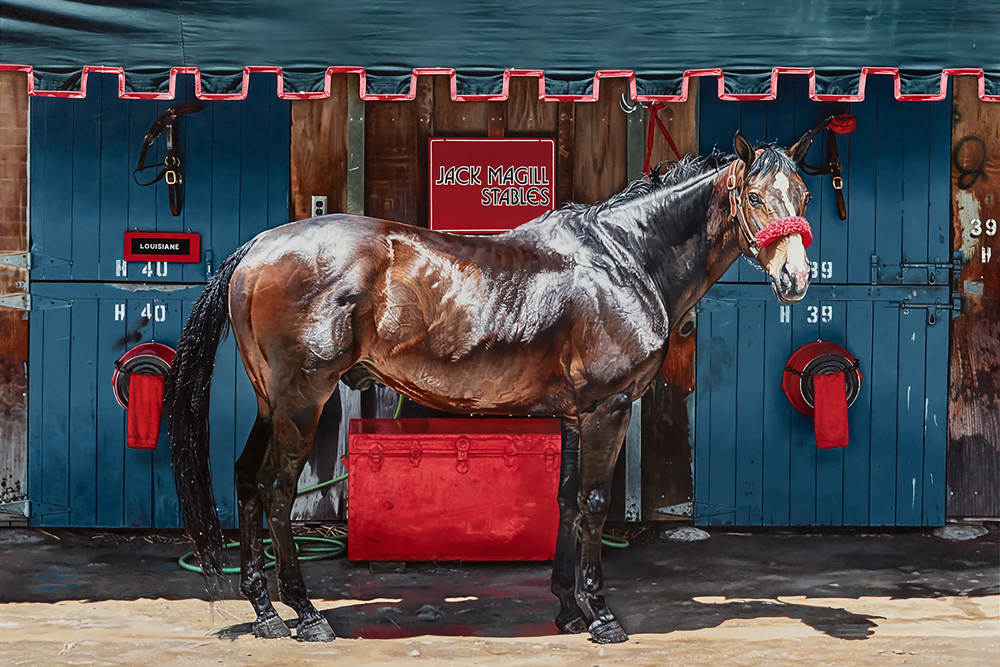It would be easy to denigrate Photorealist painting. Critics have tended not to take it very seriously, either for its lavishing of skill and technique on the goal of verisimilitude, surely naive in the era of abstraction and conceptualism, or for its secondariness in relation to photography, or for its uncritical gaze upon the objects and trappings of American empire.
On the evidence of ‘Picture This: Photorealism 1966-1985’, however, an exhibition in two parts at Waddington Custot this spring and summer which draws on the largest private collection of Photorealist painting in the world, this would be to miss the real power, strangeness and variety of the works described as ‘Photorealist’ – a word that itself comes to seem simplistic.
Part one contains works by 10 painters, including Richard Estes, Ralph Goings, Don Eddy, Robert Bechtle and John Baeder. Although from a distance the paintings seem to present a uniform smoothness of surface and procedure, as well as rather similar subject matter (cars, motorbikes, diners, hamburger stands, and other Americana), closer up there are significant differences between them. It is a commonplace of modernist culture that those artists or writers whose style seems most stripped of the personal and subjective are often those who are most recognisably and authoritatively themselves in their work. (Who could mistake a Mondrian for a painting by anybody else?). So it is with many of these works, which draw our attention to the act of looking itself even while they seem to efface the presence of the artist.
Bananas, Apples, Avocados, Tomatoes; Supermarket Window III (1973), Don Eddy. Courtesy Waddington Custot

As Don Eddy said in 1972, ‘The idea of being photographic or true to life doesn’t really interest me. It’s the references between what we know, what we see, what we think we see and what’s there, between the surface of the canvas and the illusion in the canvas.’
Eddy’s point is borne out by his pictures in this exhibition. Bananas, Apples, Avocados, Tomatoes; Supermarket Window III (1973) is a beguilingly clever composition, a painting which contains several simultaneous images in complex overlay. We are presented with a plate-glass shopfront which we can partly see into. The strip lights inside are visible, and there are cellophane-wrapped goods in the window, but the brighter light outside causes the reflection of the buildings opposite to appear more clearly in the glass. Eye and brain at first scramble to process the image, to sort its elements into some kind of sense; once this has happened, the painting becomes not just a remarkable technical feat but also a commentary on the nature of the pictorial images. It reminds us that photographs were never neutral, flat representations of reality in the first place – that the image is both formed and deformed through its technological and perceptual mediation. The painstaking act of making a painting out of it brings the painterliness of the work to our attention, even while the absence of visible brushstrokes might seem to deny the hand of the artist.
Richmond Diner (1983), Ralph Goings. Courtesy Waddington Custot

Likewise, there are both conceptual subtlety and more painterly texture than one would expect in many of the other paintings. A painting like Ralph Goings’s Richmond Diner (1983), a Hopper-esque study of an empty diner in the morning when the nighthawks have all gone home, becomes a virtuoso study of how light plays across different kinds of shiny surface and how it is resolved by the lens and the eye into an image. Richard Cottingham’s Parking Lot (1966) has a Photorealist surface when viewed from a distance, but close up the brush-strokes are much thicker and freer than we would expect, the oil paint raised up in slicks. The cropping of the image, so that no complete car can be seen within the frame, turns the realist subject matter into an almost abstract arrangement of patches of different colour. Like many of the other pictures of cars, motorbikes and toys, it is also interested in its own painterliness on another level, since it is a painting of an object that was already itself painted – an attempt to represent in paint the effect of light upon painted surfaces.
Parking Lot (1966), Robert Cottingham. Courtesy Waddington Custot

It is striking that there are no human figures in the exhibition – the magnificent horse in Richard McLean’s canvas Jack Magill’s Bourbon Jet (1981), itself as shiny as a race-car, is the only living creature we get – and that there are no women in an exhibition of paintings so often committed to investigating the visual qualities of cars. We might ask, where have all the feelings gone? And what is the political meaning of all this? But then, cars have also been one place where men have put their feelings, and all of these pictures can be understood as mournful, or elegiac, or casting a cold eye upon the commodity culture of American late capitalism. Why shouldn’t a commitment to making pictures of beautifully empty American landscapes, of commodities as signs of desires with the human subject blanked out, be an appropriate response to the era of Cold-war suppression?
‘Picture This: Photorealism 1966–1985, pt. 1’ is at Waddington Custot, London until 20 May.



